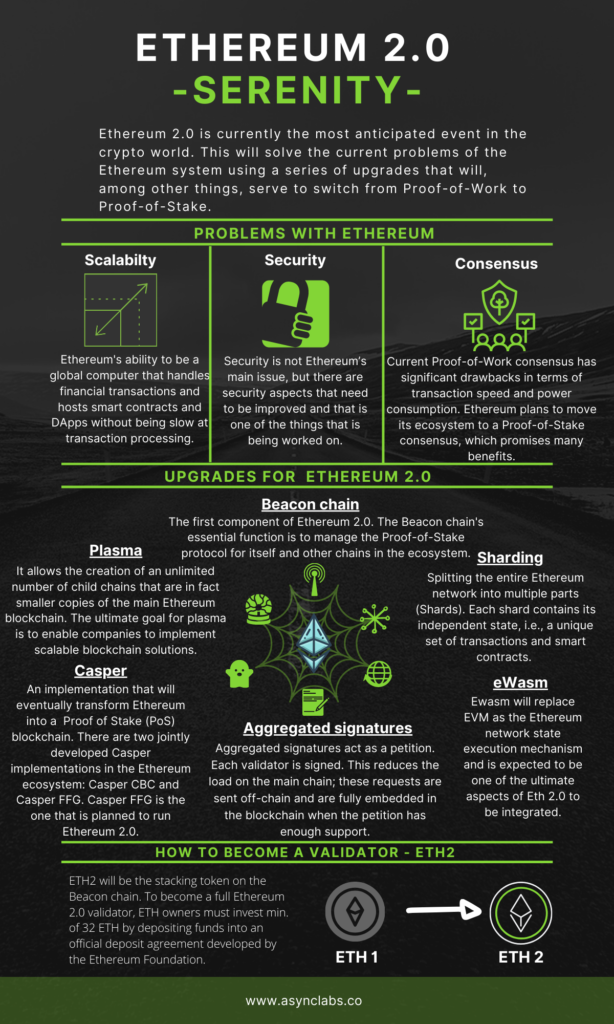Seemingly big things await the second-largest cryptocurrency in terms of market capitalization. Ethereum 2.0 is currently the most significant event in the crypto world.
This should solve the current problems of the Ethereum system by implementing the upgrades that will serve, among other things, to switch from Proof-of-Work to Proof-of-Stake consensus algorithms.
In this article, we will write about current Ethereum issues, upgrade which should resolve the problems named, but we will also tell you how to become a validator on the Ethereum 2.0 platform.
What is the problem with ethereum?
Scalability is the most significant problem faced by all crypto projects.
Due to the decentralized nature of the blockchain ecosystem, the speed of transaction processing has been compromised compared to existing centralized payment systems.
It is common to have to compromise between transaction speed and system decentralization when determining scalability in a crypto project. The decentralization of the system depends on consensus, but we will discuss it later in the article.
Ethereum claims that, with upcoming updates, it will be able to process transactions extremely fast without reducing ecosystem decentralization, which is the primary goal of any crypto project. Still, no one has succeeded in that so far.
Security has become a growing problem for Ethereum due to the increasing number of decentralized applications and the expansion of its ecosystems. Lately, it can often be seen how a particular DeFi protocol (decentralized finance) was hacked.
A study on the security of the Ethereum platform was published last year. It describes a total of 44 different Ethereum system vulnerabilities, 26 of which are in the ‘application layer’, where smart contracts and decentralized applications are made.
Due to hacks, over $ 370 million was stolen from the Ethereum ecosystem.
The consensus algorithm is the process through which all participants in a blockchain network reach a joint agreement on a distributed ledger’s current state.
Currently, the only fully proven consensus is the one used initially within the Bitcoin blockchain, Proof-of-Work. Although extremely secure, if it has a large number of participants in the network, the PoW consensus has significant drawbacks in terms of transaction speed and power consumption.
Ethereum plans to move its ecosystem to a Proof-of-Stake consensus, which promises many benefits. It has yet to be tested by a crypto project with as many users as Ethereum. You can read more about consensus algorithms in our technical article.
Upgrades in the transition to Ethereum 2.0
A series of planned upgrades should address the above, but also many other issues that Ethereum faces. Upgrades will be released gradually, without an exact schedule.
After the implementation of all upgrades, Serenity is created, which is a synonym for Ethereum 2.0. From a series of upgrades, we have singled out the most important ones.
What is ethereum 2.0 beacon chain?
Beacon chain – The first component of Ethereum 2.0
The Beacon chain’s essential function is to manage the Proof-of-Stake protocol for itself and other chains in the ecosystem. The Beacon chain is a brand new PoS blockchain. It works in parallel with the current Ethereum blockchain and tries to solve the scalability problem.
The smart contract will allow validators to participate in the PoS protocol after staking their ETH tokens. When validators pledge ETH to a smart contract, they are put in the Beacon chain. The Beacon chain will randomly select validators for the next block proposal and voting process.
Random selection in the Beacon chain is essential. As a result, it stops the association of certain validators and their negative impact on the system.
What Sharding means?
Sharding – Splitting the entire Ethereum network into multiple parts (Shards)
Each shard contains its independent state, i.e., a unique set of transactions and smart contracts. Sharding is also part of the Ethereum 2.0 upgrade. This upgrade should partly solve the scaling problem.
Sharding is like adding new chains to process multiple transactions. Each shard is a separate blockchain with its status and transaction history. But all shards have the same PoS consensus with Beacon Chain.
Registered validators on the Beacon chain will become a global set of validators. So they validate the blocks on the Beacon chain and the shards.
eWasm – Smart contracts are one of the critical parts of Ethereum
They are currently written in the Solidity or Vyper programming languages and compiled in Ethereum Virtual Machine (EVM).
eWASM replaces EVM. eWASM is based on WebAssembly (WASM). This change will make a massive difference in the number of transactions that can be processed and added to the block.
The software is designed so that errors can be easily spotted and debugged. This is accomplished in a text format that people can read, enabling code to be viewed manually, written, and debugged. As a result, the network will also be more secure and will support more programming languages.
Casper – Most blockchains rely on the PoW consensus algorithm
As a result, the network is secure because hacking it would be extremely expensive. But this type of consensus consumes much electricity, even more than the whole country of Switzerland.
Casper was developed to solve the PoW problem. With Ethereum 2.0, Ethereum tries to prevent the waste of computing power and electricity.
There are two types of implementations. The first is called the Friendly Finality Gadget (FFG) and the second the Correct Buy Constructions (CBC). FFG is a combination of PoW and PoS. CBC is an entirely new PoS concept.
How does ethereum plasma work?
Plasma – Plasma is another Ethereum scalability solution
For example, Ethereum is currently able to perform 13-15 transactions per second. Visa currently processes 20,000 transactions per second. So if cryptocurrencies like Ethereum want to replace Visa and act like digital money, they need to increase their capacity.
The goal of Plasma is just that. It is a technique for conducting off-chain transactions, relying on the Ethereum blockchain. Thus it always maintains the same level of security. During transaction processing, this operation is removed from Ethereum’s main blockchain and run off-chain instead.
Collective signatures – Collective signatures act as a petition. Therefore, the petition is sent to each validator, who then puts his signature in it.
To reduce the main chain burden, these petitions are also sent off-chain and are fully embedded in the blockchain when the petition has a sufficient number of signatures.

ETH 2 – how to become a validator on the Ethereum 2.0 platform?
Staking is the process by which validators bind their ETH to the Ethereum 2.0 blockchain to suggest and confirm the existence of new blocks.
To become a full validator of Ethereum 2.0, ETH owners must invest 32 ETH by depositing funds into an official deposit agreement developed by the Ethereum Foundation.
ETH owners who want to invest money do not have to act during “Phase 0” and can join the network as a validator whenever they want.
However, unlike other validators who have to wait until phase 1.5 to see their ETH in the Ethereum 2.0 chain, the first validators can submit their funds to the blockchain, starting with the genesis block.
The impetus for this is the potential for higher rewards per block. It is estimated that validators will earn about 10% annual interest on their stake.
Requirements to become validator:
- At least 32 ETH per validator
- A computer with proper hardware specifications
- Internet connection
What’s coming next?
Serenity will be able to support a very high number of transactions on the blockchain and have a balanced ratio of decentralization and security.
This blockchain technology can potentially become an infrastructure for universal value transfer in the world. It also has the potential to be a platform for the development of a new economic system and global cooperation models.
Be prepared for significant changes!
If you want to build a blockchain app, don’t hesitate to contact us.
